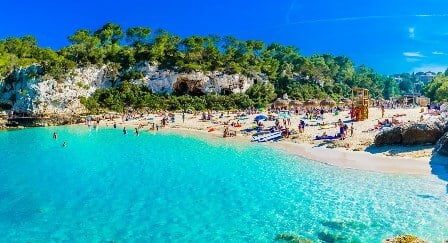Mallorca Island, also known as Majorca, is the largest island in the Balearic Islands, a group of islands that are part of Spain and located in the Mediterranean. The capital of Mallorca is Palma, and it is also the capital of the autonomous community of the Balearic Islands.
The Balearic Islands became an autonomous region of Spain in 1983. There are two small islands off the coast of Mallorca: Cabrera, located southeast of Palma, and Dragonera, located west of Palma.
The anthem of Mallorca is “La Balanguera.” The other Balearic Islands, Menorca, Formentera, and Ibiza, are popular holiday destinations, particularly for tourists from the Netherlands, Germany, and the United Kingdom.
Palma de Mallorca Airport is an international airport and one of the busiest airports in Spain. It served 28 million passengers in 2017, with numbers increasing every year since 2012.
Mallorca has a Mediterranean climate with mild, relatively wet winters and hot, dry, bright summers. Precipitation is higher in the Serra de Tramuntana.

In Mallorca Island Summers are very hot in the plains, while winters are mild. It becomes colder and wetter in the Tramuntana range.
Especially in Puig Major, it snows during the winter. The wettest months in Mallorca are October and November. Storms and heavy rain are less common during the autumn.
There are several forms of transportation available to Mallorca Island, including air travel through the airport, the bus system, trackless trains, water transport, and cycling. The Palma de Mallorca Airport, Mallorca rail network (Palma de Mallorca Metro and Ferrocarril de Soller), Mallorca bus system and trackless trains operate in several tourist areas.
There are approximately 79 ferries from Mallorca to other destinations each week, most of which go to mainland Spain (Balearia) and the Balearic Islands from Denia, Valencia, and Barcelona.
Trasmediterranea Company operates regular lines in both directions from Barcelona to Palma de Mallorca, Ibiza, and Mahon, Valencia to Palma de Mallorca, Ibiza, and Mahon, and Gandia to Palma de Mallorca and Ibiza.
Cycling is a popular activity in Mallorca, with many cycling routes available, including the popular 24 km cycle track, a segregated cycle lane that runs between Porto Cristo and Cala Bona via Sa Coma and Cala Millor.
Archduke Ludwig Salvator of Austria is considered the architect of tourism in the Balearic Islands. He first arrived on the island in 1867 and traveled under the title Count of Neuendorf. He later settled in Mallorca, buying up wild areas of land to preserve and enjoy them.
There are now several trekking routes named after him. Salvator loved the island of Mallorca and became fluent in Catalan. He conducted research into the island’s flora and fauna, history, and culture to produce his main work. There are now several streets or buildings on the island named after Arxiduc Lluis Salvador.
Mallorca is the largest island in the Balearic Islands by population, and it is also the second most populous island in Spain (after Tenerife in the Canary Islands).
It is also the fourth most populous island in the Mediterranean, after Sicily, Cyprus, and Sardinia. The officially estimated population of Mallorca was 896,038 inhabitants at the start of 2019.
There are two official languages in Mallorca: Catalan and Spanish.
Catalan is the earliest language spoken on the island. The local dialect of Catalan spoken on Mallorca is Mallorquin, which has slightly different variations in most villages. Education in Mallorca is multilingual, with instruction in Catalan, Spanish, and some English.
